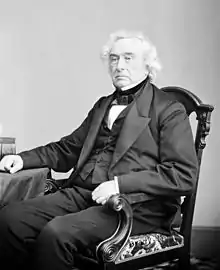1836 United States presidential election
The 1836 United States presidential election was the 13th quadrennial presidential election, held from Thursday, November 3 to Wednesday, December 7, 1836. In the third consecutive election victory for the Democratic Party, incumbent Vice President Martin Van Buren defeated four candidates fielded by the nascent Whig Party.
| |||||||||||||||||||||||||||||||||||||||||||||||||||||||||||||||||||||
294 members of the Electoral College 148 electoral votes needed to win | |||||||||||||||||||||||||||||||||||||||||||||||||||||||||||||||||||||
|---|---|---|---|---|---|---|---|---|---|---|---|---|---|---|---|---|---|---|---|---|---|---|---|---|---|---|---|---|---|---|---|---|---|---|---|---|---|---|---|---|---|---|---|---|---|---|---|---|---|---|---|---|---|---|---|---|---|---|---|---|---|---|---|---|---|---|---|---|---|
| Turnout | 57.8%[1] | ||||||||||||||||||||||||||||||||||||||||||||||||||||||||||||||||||||
| |||||||||||||||||||||||||||||||||||||||||||||||||||||||||||||||||||||
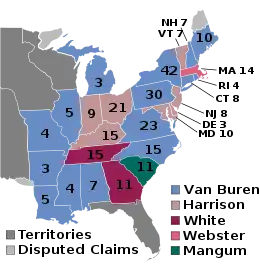 Presidential election results map. Blue denotes states won by Van Buren and Johnson or Smith, pale grey-purple denotes those won by Harrison and Granger or Tyler, purple denotes those won by White/Tyler, coral pink denotes those won by Webster/Granger, and bluegrass green denotes those won by Mangum/Tyler. Numbers indicate the number of electoral votes allotted to each state. | |||||||||||||||||||||||||||||||||||||||||||||||||||||||||||||||||||||
| |||||||||||||||||||||||||||||||||||||||||||||||||||||||||||||||||||||
1837 contingent U.S. vice presidential election | |||||||||||||||||||||||||||||||||||||||||||||||||||||||||||||||||||||
| |||||||||||||||||||||||||||||||||||||||||||||||||||||||||||||||||||||
52 United States Senators 27 votes needed to win | |||||||||||||||||||||||||||||||||||||||||||||||||||||||||||||||||||||
| |||||||||||||||||||||||||||||||||||||||||||||||||||||||||||||||||||||
The 1835 Democratic National Convention chose a ticket of Van Buren, President Andrew Jackson's handpicked successor, and US Representative Richard Mentor Johnson of Kentucky. The Whig Party, which had only recently emerged and was primarily united by opposition to Jackson, was not yet sufficiently organized to agree on a single candidate. Hoping to compel a contingent election in the House of Representatives by denying the Democrats an electoral majority, the Whigs ran multiple candidates. Most Northern and border state Whigs supported the ticket led by former Senator William Henry Harrison of Ohio, while most Southern Whigs supported the ticket led by Senator Hugh Lawson White of Tennessee. Two other Whigs, Daniel Webster and Willie Person Mangum, carried Massachusetts and South Carolina respectively on single-state tickets.
Despite facing multiple candidates, Van Buren won a majority of the electoral vote, and he won a majority of the popular vote in both the North and the South. Nonetheless, the Whig strategy came very close to success, as Van Buren won the decisive state of Pennsylvania by just over two points. As Virginia's electors voted for Van Buren but refused to vote for Johnson, Johnson fell one vote short of an electoral majority, compelling a contingent election for Vice President. In that contingent election, the United States Senate elected Johnson over Harrison's running mate, Francis Granger, on the first ballot.
Van Buren was the third incumbent Vice President to win election as President, an event which would not happen again until 1988. Harrison finished second in both the popular and electoral vote, and his strong performance helped him win the Whig nomination in the 1840 presidential election. The election of 1836 was crucial in developing the Second Party System and a stable two-party system more generally. By the end of the election, nearly every independent faction had been absorbed by either the Democrats or the Whigs.[2]
Nominations
Democratic Party nomination
| 1836 Democratic Party ticket | |||||||||||||||||||||||||||||
| Martin Van Buren | Richard M. Johnson | ||||||||||||||||||||||||||||
|---|---|---|---|---|---|---|---|---|---|---|---|---|---|---|---|---|---|---|---|---|---|---|---|---|---|---|---|---|---|
| for President | for Vice President | ||||||||||||||||||||||||||||
 |
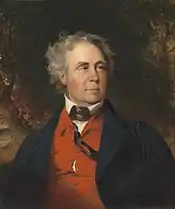 | ||||||||||||||||||||||||||||
| 8th Vice President of the United States (1833–1837) |
U.S. Representative for Kentucky's 13th (1833–1837) | ||||||||||||||||||||||||||||
| Campaign | |||||||||||||||||||||||||||||
The 1835 Democratic National Convention was held in Baltimore, Maryland, on 20-22 May 1835. Incumbent President Andrew Jackson had announced his retirement after two terms, and publicly endorsed a ticket of his Vice President, Martin Van Buren of New York, and Representative Richard M. Johnson of Kentucky, a hero in the War of 1812.
Some Southerners opposed Johnson's nomination, due to his open relationship with a slave woman, whom he had regarded as his common-law wife. At the convention, Van Buren was nominated unanimously, but the Virginia delegates supported Senator William Cabell Rives against Johnson. However, Rives got little support, and Johnson was also nominated.[3]
| Presidential vote | Vice Presidential vote | ||
|---|---|---|---|
| Martin Van Buren | 265 | Richard M. Johnson | 178 |
| William C. Rives | 87 |
Whig Party nomination
The Whig Party emerged during the 1834 mid-term elections as the chief opposition to the Democratic Party. The party was formed from members of the National Republican Party, the Anti-Masonic Party, disaffected Jacksonians, and small remnants of the Federalist Party (people whose last political activity was with them a decade before). Some Southerners who were angered by Jackson's opposition to states' rights, including Sen. John C. Calhoun and the Nullifiers, also temporarily joined the Whig coalition.[3]
Unlike the Democrats, the Whigs did not hold a national convention. Instead, state legislatures and state conventions nominated candidates. Southern Nullifiers placed Tennessee Senator Hugh Lawson White into contention for the presidency in 1834 soon after his break with Jackson. White was a moderate on the states' rights issue, which made him acceptable in the South, but not in the North. The state legislatures of Alabama and Tennessee officially nominated White. The South Carolina state legislature nominated Senator Willie Person Mangum of North Carolina. By early 1835, Massachusetts Senator Daniel Webster was building support among Northern Whigs. Both Webster and White used Senate debates to establish their positions on the issues of the day, as newspapers carried the text of their speeches nationwide. The Pennsylvania legislature nominated popular former general William Henry Harrison, who had led American forces at the Battle of Tippecanoe. The Whigs hoped that Harrison's reputation as a military hero could win voter support. Harrison soon displaced Webster as the preferred candidate of Northern Whigs. State legislatures, particularly in larger states, also nominated various vice presidential candidates.[3]
Despite multiple candidates, there was only one Whig ticket in each state. The Whigs ended up with two main tickets: William Henry Harrison for president and Francis Granger for vice-president in the North and the border states, and Hugh Lawson White for president and John Tyler for vice-president in the middle and lower South. In Massachusetts, the ticket was Daniel Webster and Granger. In South Carolina, the ticket was Mangum for president and Tyler for vice-president. Of the four Whig presidential candidates, only Harrison was on the ballot in enough states for it to be mathematically possible for him to win a majority in the Electoral College, and even then, it would have required him to win Van Buren's home state of New York.[3]
Anti-Masonic Party nomination
After the negative views of Freemasonry among a large segment of the public began to wane in the mid 1830s, the Anti-Masonic Party began to disintegrate. Some of its members began moving to the Whig Party, which had a broader issue base than the Anti-Masons. The Whigs were also regarded as a better alternative to the Democrats.
A state convention for the Anti-Masonic Party was held in Harrisburg, Pennsylvania from December 14–17, 1835, to choose Presidential Electors for the 1836 election. The convention unanimously nominated William Henry Harrison for President and Francis Granger for Vice President. The Vermont state Anti-Masonic convention followed suit on February 24, 1836. Anti-Masonic leaders were unable to obtain assurance from Harrison that he was not a Mason, so they called a national convention. The second national Anti-Masonic nominating convention was held in Philadelphia on May 4, 1836. The meeting was divisive, but a majority of the delegates officially stated that the party was not sponsoring a national ticket for the presidential election of 1836 and proposed a meeting in 1837 to discuss the future of the party.
Nullifier Party nomination
The Nullifier Party had also begun to decline sharply since the previous election, after it became clear that the doctrine of nullification lacked sufficient support outside of the party's political base of South Carolina to ever make the Nullifiers more than a fringe party nationwide. Many party members began to drift towards the Democratic Party, but there was no question of the party endorsing Van Buren's bid for the presidency, as he and Calhoun were sworn enemies. Seeing little point in running their own ticket, Calhoun pushed the party into backing the White/Tyler ticket, as White had previously sided against Jackson during the Nullification Crisis.
General election
Campaign
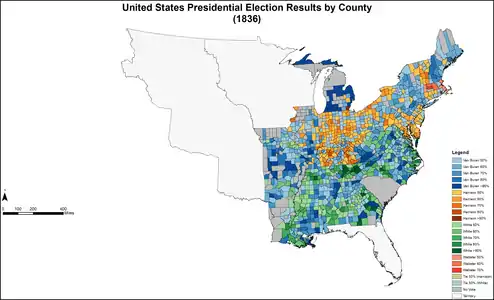
In the aftermath of the Nat Turner slave rebellion and other events, slavery emerged as an increasingly prominent political issue. Calhoun attacked Van Buren, saying that he could not be trusted to protect Southern interests and accusing the sitting Vice President of affiliating with abolitionists.[3] Van Buren defeated Harrison by a margin of 51.4% to 48.6% in the North, and he defeated White by a similar margin of 50.7% to 49.3% in the South.
Disputes
A dispute similar to that of Indiana in 1817 and Missouri in 1821 arose during the counting of the electoral votes. Michigan only became a state on January 26, 1837, and had cast its electoral votes for president before that date. Anticipating a challenge to the results, Congress resolved on February 4, 1837, that during the counting four days later the final tally was read twice, once with Michigan and once without Michigan. The counting proceeded in accordance with the resolution. The dispute had no bearing on the final result: either way Van Buren was elected, and either way no candidate had a majority for vice-president.[4]
Results
The Whigs' strategy narrowly failed to prevent Van Buren's election as President, though he earned a somewhat lower share of the popular vote and fewer electoral votes than Andrew Jackson had in either of the previous two elections.
The key state in this election was ultimately Pennsylvania, which Van Buren won from Harrison with a narrow majority of just 4,222 votes. Had Harrison won the state, Van Buren would have been left eight votes short of an Electoral College majority - despite receiving a majority (50.48%) in the popular vote - and the Whig goal to force the election into the House of Representatives (in accordance with the Twelfth Amendment to the United States Constitution) would have succeeded.
In a contingent election, the House would have been required to choose between Van Buren, Harrison, and White as the three candidates with the most electoral votes. However, given that the Democrats held a majority in the House and that Van Buren had received a popular vote majority, Van Buren would have quite likely been elected President.
Further to this, Virginia's 23 electors, who were all pledged to Van Buren and his running mate, Richard Mentor Johnson, became faithless electors due to dissention related to Johnson's interracial relationship with a slave[5] and refused to vote for Johnson, instead casting their vice-presidential votes for former South Carolina senator William Smith.
This left Johnson one electoral vote short of an Electoral College majority, forcing a contingent election in the Senate decided between the top two vote recipients, Johnson and Francis Granger; Johnson was elected on the first ballot.
This was the last election in which the Democrats won Connecticut, Rhode Island, and North Carolina until 1852. This was also the only election where South Carolina voted for the Whigs, and the last time it voted against the Democrats until 1868. It was also the last time that a Democrat was elected to the U.S. presidency succeeding a Democrat who had served two terms as U.S. president.[6]
| Presidential candidate | Party | Home state | Popular vote(a) | Electoral vote | |
|---|---|---|---|---|---|
| Count | Percentage | ||||
| Martin Van Buren | Democratic | New York | 764,176 | 50.83% | 170 |
| William Henry Harrison | Whig | Ohio | 550,816 | 36.63% | 73 |
| Hugh Lawson White | Whig | Tennessee | 146,107 | 9.72% | 26 |
| Daniel Webster | Whig | Massachusetts | 41,201 | 2.74% | 14 |
| Willie Person Mangum | Whig | North Carolina | —(b) | — | 11 |
| Other | 1,234 | 0.08% | 0 | ||
| Total | 1,503,534 | 100.0% | 294 | ||
| Needed to win | 148 | ||||
Source (Popular Vote): Leip, David. "1836 Presidential Election Results". Dave Leip's Atlas of U.S. Presidential Elections. Retrieved July 27, 2005. Source (Electoral Vote): "Electoral College Box Scores 1789–1996". National Archives and Records Administration. Retrieved July 31, 2005.
(a) The popular vote figures exclude South Carolina where the electors were chosen by the state legislature rather than by popular vote.
(b) Mangum received his electoral votes from South Carolina where the electors were chosen by the state legislatures rather than by popular vote.
| Vice presidential candidate | Party | State | Electoral vote |
|---|---|---|---|
| Richard M. Johnson | Democratic | Kentucky | 147 |
| Francis Granger | Whig | New York | 77 |
| John Tyler | Whig | Virginia | 47 |
| William Smith | Democratic | Alabama | 23 |
| Total | 294 | ||
| Needed to win | 148 | ||
Source: "Electoral College Box Scores 1789–1996". National Archives and Records Administration. Retrieved July 31, 2005.
Cartographic gallery
 Map of presidential election results by county
Map of presidential election results by county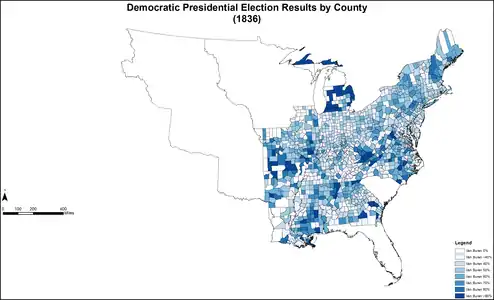 Map of Democratic presidential election results by county
Map of Democratic presidential election results by county Map of Harrison Whig presidential election results by county
Map of Harrison Whig presidential election results by county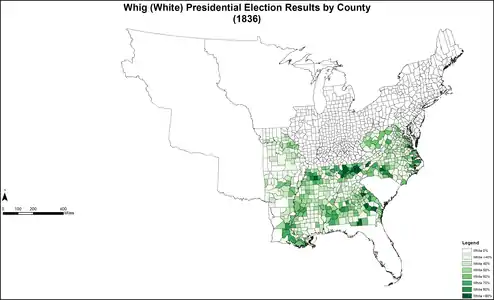 Map of White Whig presidential election results by county
Map of White Whig presidential election results by county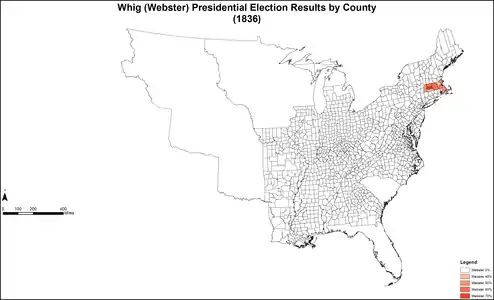 Map of Webster Whig presidential election results by county
Map of Webster Whig presidential election results by county
Results by state
Source: Data from Walter Dean Burnham, Presidential ballots, 1836-1892 (Johns Hopkins University Press, 1955) pp 247–57.
| States/districts won by Van Buren/Johnson |
| States/districts won by a Whig candidate |
| Martin Van Buren Democratic |
William H. Harrison Whig |
Hugh L. White Whig |
Daniel Webster Whig |
Willie Person Mangum Whig |
Margin | Total | ||||||||||||
|---|---|---|---|---|---|---|---|---|---|---|---|---|---|---|---|---|---|---|
| State | electoral votes |
Votes cast | % | electoral votes |
Votes cast | % | electoral votes |
Votes cast | % | electoral votes |
Votes cast | % | electoral votes |
electoral votes |
# | % | # | |
| Alabama | 7 | 20,638 | 55.34 | 7 | no ballots | 16,658 | 44.66 | 0 | no ballots | no ballots | 3,980 | 10.68 | 37,296 | AL | ||||
| Arkansas | 3 | 2,380 | 64.08 | 3 | no ballots | 1,334 | 35.92 | 0 | no ballots | no ballots | 1,046 | 28.16 | 3,714 | AR | ||||
| Connecticut | 8 | 19,294 | 50.65 | 8 | 18,799 | 49.35 | 0 | no ballots | no ballots | no ballots | 495 | 1.30 | 38,093 | CT | ||||
| Delaware | 3 | 4,154 | 46.70 | 0 | 4,736 | 53.24 | 3 | no ballots | no ballots | no ballots | -582 | -6.54 | 8,895 | DE | ||||
| Georgia | 11 | 22,778 | 48.20 | 0 | no ballots | 24,481 | 51.80 | 11 | no ballots | no ballots | -1,703 | -3.60 | 47,259 | GA | ||||
| Illinois | 5 | 18,369 | 54.69 | 5 | 15,220 | 45.31 | 0 | no ballots | no ballots | no ballots | 3,149 | 9.38 | 33,589 | IL | ||||
| Indiana | 9 | 32,478 | 44.03 | 0 | 41,281 | 55.97 | 9 | no ballots | no ballots | no ballots | -8,803 | -11.94 | 73,759 | IN | ||||
| Kentucky | 15 | 33,229 | 47.41 | 0 | 36,861 | 52.59 | 15 | no ballots | no ballots | no ballots | -3,632 | -5.18 | 70,090 | KY | ||||
| Louisiana | 5 | 3,842 | 51.74 | 5 | no ballots | 3,583 | 48.26 | 0 | no ballots | no ballots | 259 | 3.48 | 7,425 | LA | ||||
| Maine | 10 | 22,825 | 58.92 | 10 | 14,803 | 38.21 | 0 | no ballots | no ballots | no ballots | 8,022 | 20.71 | 38,740 | ME | ||||
| Maryland | 10 | 22,267 | 46.27 | 0 | 25,852 | 53.73 | 10 | no ballots | no ballots | no ballots | -3,585 | -7.46 | 48,119 | MD | ||||
| Massachusetts | 14 | 33,486 | 44.81 | 0 | no ballots | no ballots | 41,201 | 55.13 | 14 | no ballots | -7,715 | -10.32 | 74,687 | MA | ||||
| Michigan | 3 | 7,122 | 56.22 | 3 | 5,545 | 43.78 | 0 | no ballots | no ballots | no ballots | 1,577 | 12.44 | 12,667 | MI | ||||
| Mississippi | 4 | 10,297 | 51.28 | 4 | no ballots | 9,782 | 48.72 | 0 | no ballots | no ballots | 515 | 2.56 | 20,079 | MS | ||||
| Missouri | 4 | 10,995 | 59.98 | 4 | no ballots | 7,337 | 40.02 | 0 | no ballots | no ballots | 3,658 | 19.96 | 18,332 | MO | ||||
| New Hampshire | 7 | 18,697 | 75.01 | 7 | 6,228 | 24.99 | 0 | no ballots | no ballots | no ballots | 12,469 | 50.02 | 24,925 | NH | ||||
| New Jersey | 8 | 25,592 | 49.47 | 0 | 26,137 | 50.53 | 8 | no ballots | no ballots | no ballots | -545 | -1.06 | 51,729 | NJ | ||||
| New York | 42 | 166,795 | 54.63 | 42 | 138,548 | 45.37 | 0 | no ballots | no ballots | no ballots | 28,247 | 9.26 | 305,343 | NY | ||||
| North Carolina | 15 | 26,631 | 53.10 | 15 | no ballots | 23,521 | 46.90 | 0 | no ballots | no ballots | 3,110 | 6.20 | 50,153 | NC | ||||
| Ohio | 21 | 96,238 | 47.56 | 0 | 104,958 | 51.87 | 21 | no ballots | no ballots | no ballots | -8,720 | -4.31 | 202,333 | OH | ||||
| Pennsylvania | 30 | 91,457 | 51.18 | 30 | 87,235 | 48.82 | 0 | no ballots | no ballots | no ballots | 4,222 | 2.36 | 178,692 | PA | ||||
| Rhode Island | 4 | 2,964 | 52.24 | 4 | 2,710 | 47.76 | 0 | no ballots | no ballots | no ballots | 254 | 4.48 | 5,674 | RI | ||||
| South Carolina | 11 | no popular vote | no popular vote | no popular vote | no popular vote | 11 | - | - | 0 | SC | ||||||||
| Tennessee | 15 | 26,170 | 42.08 | 0 | no ballots | 36,027 | 57.92 | 15 | no ballots | no ballots | -9,857 | -15.84 | 62,197 | TN | ||||
| Vermont | 7 | 14,037 | 40.07 | 0 | 20,994 | 59.93 | 7 | no ballots | no ballots | no ballots | -6,957 | -19.86 | 35,031 | VT | ||||
| Virginia | 23 | 30,556 | 56.64 | 23 | no ballots | 23,384 | 43.35 | 0 | no ballots | no ballots | 7,172 | 13.29 | 53,945 | VA | ||||
| TOTALS: | 294 | 763,291 | 50.79 | 170 | 549,907 | 36.59 | 73 | 146,107 | 9.72 | 26 | 41,201 | 2.74 | 14 | 11 | 213,384 | 14.20 | 1,502,811 | US |
| TO WIN: | 148 | |||||||||||||||||
Close states
States where the margin of victory was under 5%:
- New Jersey 1.06%
- Connecticut 1.3%
- Pennsylvania 2.36%
- Mississippi 2.56%
- Louisiana 3.48%
- Georgia 3.6%
- Ohio 4.31%
- Rhode Island 4.48%
States where the margin of victory was under 10%:
- Kentucky 5.18%
- North Carolina 6.2%
- Delaware 6.54%
- Maryland 7.46%
- New York 9.26%
- Illinois 9.38%
Tipping point states:
- Pennsylvania 2.36% (tipping point state for a Van Buren victory)
- New York 9.26% (tipping point state for a Harrison victory)
Breakdown by ticket
| Candidate | Total | Martin Van Buren Democratic |
William H. Harrison Whig |
Hugh L. White Whig |
Daniel Webster Whig |
Willie P. Mangum Whig |
|---|---|---|---|---|---|---|
| Electoral Votes for President | 294 | 170 | 73 | 26 | 14 | 11 |
| For Vice President, Richard Mentor Johnson | 147 | 147 | ||||
| For Vice President, Francis Granger | 77 | 63 | 14 | |||
| For Vice President, John Tyler | 47 | 10 | 26 | 11 | ||
| For Vice President, William Smith | 23 | 23 |
1837 contingent election
Since no candidate for vice president received a majority of the electoral votes, the U.S. Senate held a contingent election in which the top two electoral vote recipients, Richard Johnson and Francis Granger, were the candidates. On February 8, 1837, Johnson was elected on the first ballot by a vote of 33 to 16; the vote proceeded largely along party lines, albeit with three Whigs voting for Johnson, one Democrat voting for Granger, and three abstentions (Hugh L. White declined to vote out of respect for his own running-mate, John Tyler, while the two Nullifier Party senators refused to back either candidate). This is the only time that the Senate has exercised this power.[7]
Electoral college selection
| Method of choosing electors | State(s) |
|---|---|
| Each Elector appointed by state legislature | South Carolina |
| Each Elector chosen by voters statewide | (all other States) |
See also
References
- "Voter Turnout in Presidential Elections". The American Presidency Project. UC Santa Barbara. Archived from the original on January 12, 2017.
- Cole, Donald B. (1984). Martin Van Buren and the American Political System. Princeton, NJ: Princeton University Press. p. 279. ISBN 0-691-04715-4. Retrieved March 23, 2017.
- Deskins, Donald Richard; Walton, Hanes; Puckett, Sherman (2010). Presidential Elections, 1789-2008: County, State, and National Mapping of Election Data. University of Michigan Press. pp. 106–107.
- United States Congress (1837). Senate Journal. 24th Congress, 2nd Session, February 4. pp. 203–204. Archived from the original on April 4, 2015. Retrieved August 20, 2006.
- Burke, Window To The Past
- https://www.thoughtco.com/two-consecutive-democratic-presidents-3368109
- "The Senate Elects a Vice President". Washington, D.C.: Office of the Secretary of the Senate. Retrieved August 11, 2019.
- "Cong. Globe, 24th Cong., 2nd Sess. 166(1837)". A Century of Lawmaking for a New Nation: U.S. Congressional Documents and Debates, 1774–1875. Washington, D.C.: Library of Congress. Retrieved August 8, 2019.
- "24th Congress Senate Vote 334 (1837)". voteview.com. Los Angeles, California: UCLA Department of Political Science and Social Science Computing. Retrieved August 8, 2019.
Further reading
- Brown, Thomas. "The miscegenation of Richard Mentor Johnson as an issue in the national election campaign of 1835-1836." Civil War History 39.1 (1993): 5-30. online
- Cheathem, Mark. R. The Coming of Democracy: Presidential Campaigning in the Age of Jackson (Johns Hopkins University Press, 2018)
- Ershkowitz, Herbert B. "The Election of 1836." in American Presidential Campaigns and Elections;; (Routledge, 2020) pp. 270-288.
- Hoffmann, William S. "The Election of 1836 in North Carolina." North Carolina Historical Review 32.1 (1955): 31-51. online
- McCormick, Richard P. "Was There a" Whig Strategy" in 1836?." Journal of the Early Republic 4.1 (1984): 47-70. online
- Shade, William G. "'The Most Delicate and Exciting Topics': Martin Van Buren, Slavery, and the Election of 1836." Journal of the Early Republic 18.3 (1998): 459-484 online.
- Silbey, Joel H. "Election of 1836," in Arthur M. Schlesinger, Jr. and Fred L. Israel, eds. History of American Presidential Elections (4 vols., 1971), I, 577-64, history plus primary sources
- Towers, Frank. "The Rise of the Whig Party." in A Companion to the Era of Andrew Jackson (2013): 328-347.
External links
- "A Historical Analysis of the Electoral College". The Green Papers. Retrieved March 20, 2005.
- "U.S. President - Whig Nominees 1836". OurCampaigns.com. Retrieved March 20, 2008.
- How close was the 1836 election? — Michael Sheppard, Massachusetts Institute of Technology
- Presidential Election of 1836: A Resource Guide from the Library of Congress
- United States presidential election of 1836 at the Encyclopædia Britannica
- Election of 1836 in Counting the Votes Archived March 4, 2016, at the Wayback Machine
| Wikimedia Commons has media related to United States presidential election, 1836. |
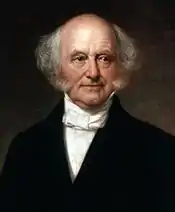
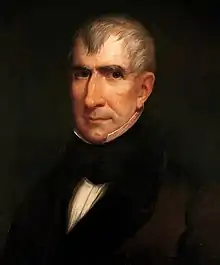
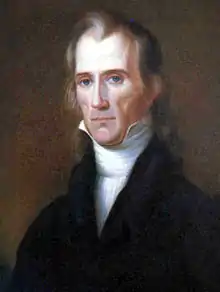
.jpg.webp)

